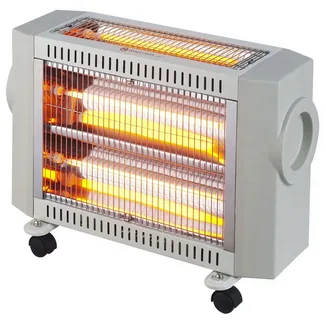Electric radiant heat are an efficient method of warming spaces, offering a unique approach compared to traditional systems. These heaters emit radiant energy that directly heats objects and people in a room rather than warming the air. This direct heating method leads to a more consistent and comfortable environment. Popular in homes and offices, electric radiant heat come in various forms, such as infrared heaters, underfloor systems, and wall-mounted units.
They are known for their energy efficiency and cost-effectiveness, often resulting in lower utility bills. Electric radiant heater ralso provide even heat distribution, eliminating cold spots and creating a uniformly warm atmosphere. Understanding these heaters’ benefits and features can help make informed purchasing decisions.
Advantages of Electric Radiant Heat
Electric radiant heat excel in energy efficiency by directly warming objects, which translates to reduced energy consumption and lower utility bills. They are known for providing consistent heat distribution, eliminating cold spots and ensuring a uniformly comfortable environment. This heater operates silently, making it ideal for bedrooms and offices where noise can distract. Additionally, the absence of moving parts reduces the risk of mechanical failure, contributing to longevity and reliability.
Many models also offer quick heat-up times, making them suitable for spaces that require rapid warming. Furthermore, they are versatile in design and available in various styles such as underfloor systems, wall-mounted units, and infrared heaters, allowing them to integrate into different spaces seamlessly.
Varieties of Electric Radiant Heat
Electric radiant heat come in various styles, each designed to cater to specific needs, spaces, and preferences. Understanding these options can help you choose the best heating solution for your home or outdoor area.
Infrared Heaters
- How They Work: Emit infrared rays that directly warm objects and people rather than the air.
- Benefits: Provides quick, targeted heating, making it energy-efficient and effective for instant warmth.
- Best For: Living areas, offices, and spaces requiring fast heating.
Underfloor Heating Systems
- How They Work: Heat is distributed evenly beneath the floor surface.
- Benefits: Offers invisible heating with consistent warmth and eliminates the need for visible heating appliances.
- Best For: Bathrooms, kitchens, and spaces where aesthetics and even heat distribution are priorities.
Wall and Ceiling-Mounted Heaters
- How They Work: Installed on walls or ceilings to save floor space while radiating heat throughout the room.
- Benefits: Space-saving, discreet, and ideal for rooms with limited floor area.
- Best For: Bedrooms, offices, and compact spaces.
Panel Heaters
- How They Work: Thin panels radiate heat, often featuring modern designs.
- Benefits: Can be wall-mounted or free-standing, offering flexibility and sleek aesthetics.
- Best For: Contemporary interiors where style and functionality are equally important.
Outdoor Radiant Heaters
- How They Work: Emit heat designed to withstand outdoor conditions, warming patios and gardens.
- Benefits: Extends the comfort of indoor heating to outdoor spaces, ideal for year-round use.
- Best For: Patios, decks, and outdoor dining areas.
Essential Features to Look for in Electric Radiant Heat
Key features to consider include thermostat control, which ensures precise temperature regulation. Safety is paramount; opt for models with overheat protection and tip-over switches to prevent accidents. Design and aesthetics are also crucial; the heater should seamlessly blend with your home decor. Energy efficiency ratings are essential, as higher ratings signify lower energy consumption and reduced utility costs.
Consider heaters with programmable timers for added convenience, allowing you to set specific operating hours. Look for models with adjustable heat settings to tailor the warmth to your needs. Noise levels can be a factor, especially in quiet environments like bedrooms and offices, so choose a heater known for silent operation. Lastly, ensure the heater has a reliable warranty to cover any potential defects or issues.
Considerations for Installing Electric Radiant Heat
Choosing between professional installation and a DIY approach depends on expertise and the system’s complexity. Professional installation guarantees safety and adherence to local regulations, especially underfloor or ceiling-mounted systems. Evaluate the most effective locations within the room for installation, targeting areas where occupants spend most of their time. Ensure adequate clearance around the heater to prevent obstruction and maximize efficiency. For wall-mounted or panel heaters, secure mounting brackets firmly to support the unit’s weight.
Confirm electrical compatibility with existing circuits to avoid overloading. Always follow the manufacturer’s installation guidelines to ensure optimal performance and safety. If installing multiple units, consider their placement to achieve uniform heat distribution. Proper planning and careful installation will enhance the heater’s effectiveness and longevity.
Maintenance Advice for Electric-Radiant Heaters
Regular maintenance ensures the efficient performance of electric radiant heat. Start by switching off and unplugging the heater before any cleaning. Wipe down surfaces with a soft, damp cloth to remove dust and debris, avoiding abrasive cleaners that can damage the finish. Inspect the heater periodically for wear or damage, such as frayed wires or loose connections. Clean filters and vents if applicable, as clogged filters can reduce efficiency.
For underfloor heating systems, ensure the floor covering remains intact and free from damage. If the heater has a thermostat, check its accuracy periodically to maintain optimal performance. Ensure the surrounding area is clear of obstructions to promote effective heat distribution. If any issues arise, refer to the manufacturer’s manual or seek professional assistance to address technical problems safely.
Comparing Electric Radiant Heat with Other Heating Systems
Electric-radiant heaters have distinct advantages over traditional heating systems. They provide direct warmth to objects and people, minimising energy loss associated with air-based heating methods. Conventional heaters often circulate air, leading to uneven heating and uncomfortable drafts. Radiant heaters operate silently, unlike traditional systems that produce noise from fans or burners. Additionally, electric radiant heat can be more eco-friendly as they have the potential to be powered by renewable energy sources.
In contrast, fossil fuel-based systems contribute to greenhouse gas emissions. The absence of moving parts in radiant heaters also means fewer maintenance issues and a longer lifespan than traditional systems. Versatility in design options allows electric radiant heat to be integrated into various environments without compromising aesthetics or space.
Purchasing Advice for Electric Radiant Heat
Assess the heating needs by considering the size of the room and the heater’s capacity. Budget is another key factor, as prices vary widely based on features and quality. Researching reviews and ratings can offer insights into performance and reliability—Prioritise models with high energy efficiency ratings to reduce operational costs. Ensure the heater has essential safety features, such as overheat protection and tip-over switches. If aesthetic appeal matters, look for designs that blend well with the room decor.
Evaluate additional features like programmable timers and remote control functionality for added convenience. Check warranty terms to ensure coverage for potential defects or issues. Consider the installation requirements, as some models may necessitate professional assistance. All these factors will guide you in selecting a heater that meets specific needs and preferences effectively.
Common Mistakes to Avoid with Electric Radiant Heat
Neglecting to consider energy efficiency ratings can lead to higher operational costs. Failing to match the heater’s capacity to the room size often results in inadequate heating or excessive energy use. Overlooking essential safety features such as overheat protection and tip-over switches can pose significant risks. Incorrect placement can reduce effectiveness; avoid placing heaters behind furniture or curtains.
Skipping regular maintenance, including cleaning and inspections, can diminish performance and shorten the heater’s lifespan. Ignoring the manufacturer’s installation guidelines may compromise safety and efficiency. Attempting complex installations without professional help can lead to improper setup and potential hazards. Lastly, choosing aesthetics over functionality can result in a less effective heating solution. Careful planning and consideration of these factors will enhance the performance and longevity of electric radiant heat.
Recent Innovations in Electric Radiant Heat
Recent advancements in electric radiant heat include smart technology integration, enabling remote control and monitoring via smartphones and smart home systems. This innovation allows for more precise energy management and increased convenience. Additionally, manufacturers are incorporating eco-friendly materials and sustainable designs to reduce the environmental impact of these heaters. Improved safety features, such as advanced overheat protection and child locks, have also been developed to enhance user safety.
Enhanced design aesthetics now offer more versatile and stylish options, allowing these heaters to blend seamlessly into modern interiors. Innovations in heat distribution technology ensure even more efficient and consistent warming, maximizing comfort in any space.
Conclusion and Final Remarks
Selecting the right electric radiant heater involves evaluating room size, energy efficiency, safety features, and design aesthetics. Understanding the various types, from infrared to underfloor systems, ensures a suitable choice for different spaces. Prioritising essential features like thermostat control and programmable timers can enhance user experience. Regular maintenance, including cleaning and periodic inspections, will ensure the heater operates efficiently and has a longer lifespan.
Frequently Asked Questions
Q: Are electric radiant heaters expensive to run?
A: They are generally more cost-effective than conventional systems due to their direct heating method, which reduces energy waste by electric radiantheater.
Q: Can I install electric radiant heat myself?
A: While some models are suitable for DIY installation, professional installation is recommended for complex systems to ensure safety and compliance.
Q: How do I maintain my electric radiant heat?
A: Regular cleaning and checking for operational issues can prolong the heater’s lifespan and ensure efficiency.
Q: What safety features should I look for in an electric radiant heat?
A: To prevent accidents, essential safety features include overheat protection, tip-over switches, and child locks.
Q: Can electric-radiant heaters be used outdoors?
A: Yes, outdoor radiant heaters are designed for external spaces like patios and gardens, extending indoor comfort to outdoor areas.
| Related Business Listings |
| Contact Directory |
| Local Business Profiles |


